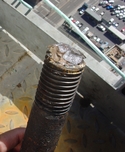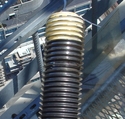Check those bolts
8 July 2008Terry McGettigan is an OSHA licensed tower crane inspector and certifier, with more than 30 years experience operating tower cranes. He wrote to Cranes Today to describe the alarming results of checks he carried out the day of the Kodiak tower crane collapse in New York City.
Before going to work on May 31, I watched the news on the most recent New York crane accident and it was immediately apparent to me that the slew-ring assembly had failed.
The first thing I did when I got to the 450ft-high top of a 2003 tower crane was to check the slew-ring bolts with a 2lb beater using minimum force. There are two rows, each with 59 bolts. With the crane balanced off, I started with the top row (the slew bearing) and when I struck the third bolt it moved, showing it was loose. I continued checking and when I hit the 28th bolt, it broke in two. I then went back to the bolt that had movement (I was going to just re-torque it) and decided to remove it for inspection, which revealed a severe crack at the same location as the one that sheared off.
I was concerned to find two bolts with similar failure, and by the likelihood that there could be many more, so I immediately put the crane out of operation. We contacted the manufacturer and are trying to arrange for a factory engineer to come out. The only certain solution is for them to thoroughly examine all of the slew-ring bolts, and if needed oversee their replacement.
Had it not been for this most recent event, I admit I would not have gone through the extra effort needed to properly inspect a slew-ring. The typical way it is done by operators and inspectors is either just a visual check while climbing through the slew-ring, or just a tap with a carpenter's hammer, relying on your sense of sound to hear a difference between bolts. The problem with this is that without balancing the crane to ensure that the load on the bearing is distributed equally, you cannot get a true sense that the bolts are equally tightened. This method will not give you a torque value anyhow! That goes for mast bolts too.
The bottom line is, the standard checks that get carried out just don't tell the whole story, especially considering the potential for loss of life and property damage. These common, time-saving methods are just not enough for what's at risk. This is a good example of why tower cranes should be thoroughly examined, and more than just once or twice a year. Tower crane examinations require expertise and time, and contractors are going to have to get used to it.
Here is what you should look for when hiring a tower crane specialist:
1. Appropriate recognised academic qualifications.
2. Relevant levels of practical experience.
3. Model-specific technical training directly from the manufacturer.
And that brings to mind the need for clear procedures and oversight during high-risk operations such as erection, dismantling and, especially, climbing.
Here are just a few common practices that many crews are doing. Some will de-torque all tower mast bolts to the point that they can be removed by hand and then climb down and/or dismantle the crane. Some disconnect limit switches to pull up or lower a climber. Others will continue climbing when hydraulics are leaking, or guide rollers are jammed or out of adjustment.
There are enough regulations and procedures in place now. The problem is that many people performing these high-risk operations are not following them to a T!
Terry McGettigan
Tower Crane Support LLC
San Diego, California


